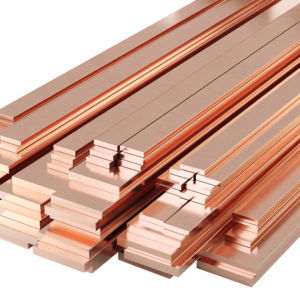1. Introduction
In the past 48 hours, global copper prices have surged due to supply chain disruptions in Chile—the world’s largest copper producer—sparking renewed interest in copper-based materials like copper rod and copper strip among contractors, electricians, and recyclers. With rising demand across renewable energy, EV infrastructure, and HVAC systems, understanding copper rod variants has never been more relevant.

Whether you’re installing an earthing system, repairing AC piping, or stripping wire for scrap, copper remains a cornerstone material thanks to its unmatched conductivity, corrosion resistance, and versatility.
2. What Is a Copper Rod?
A copper rod is a solid cylindrical bar made from high-purity copper, typically used in electrical, industrial, and construction applications. Also referred to as rod copper or copper round bar, it comes in various diameters and tempers (soft, half-hard, hard).
Copper rods serve as raw stock for manufacturing wires, bus bars, and connectors—but they’re also used directly as grounding electrodes, welding fillers, and structural components.
3. Types of Copper Rods and Their Uses
3.1. Copper Earth Rod and Grounding Variants
For electrical safety, the copper earth rod (also called earthing rod copper or ground rod copper) is driven into the soil to dissipate fault currents. Pure copper rods offer excellent longevity but are expensive.
More cost-effective alternatives include:
- Copper bonded earthing rod: Steel core with a thick copper layer (typically 0.25mm+), offering strength and conductivity.
- Copper clad steel ground rod: Similar to bonded rods but with a metallurgically bonded copper cladding.
- Copper clad earth rod and copper clad steel earth rod: Used interchangeably; both provide corrosion resistance at lower cost than solid copper.
When comparing earthing rod price, copper bonded options often deliver the best balance of performance and affordability.
3.2. Copper Rods for Joining and Fabrication

Welding and brazing require specialized filler materials:
- Copper brazing rod and copper to copper brazing rods are used for joining copper components without melting the base metal.
- Copper welding rod, copper rod for welding, and copper to copper welding rod are essential for TIG or oxy-acetylene processes on pure copper parts.
- Welding rod copper must match the alloy composition to ensure joint integrity—especially in plumbing or refrigeration lines.
Note: Copper rod welding demands preheating and skilled technique due to copper’s high thermal conductivity.
4. Copper Strip vs. Copper Rod: When to Use Which?
While copper rod is round and solid, copper strip (or flat copper strip) is thin, flat, and flexible—ideal for busbars, grounding straps, or EMI shielding.
Common variants include:
- Thin copper strips and 1mm copper strip for electronics.
- Beryllium copper strip and copper beryllium strip for springs and connectors requiring high strength.
- Nickel plated copper strip for enhanced solderability and corrosion resistance.
- Copper earth strip 25x3mm price varies by region but is widely used in substation grounding grids.
Recyclers often seek copper strip near me when sourcing materials like copper strip wire or stripping cable for copper. For scrap purposes, the best way to strip copper wire includes mechanical strippers—not burning copper wire for scrap, which is illegal and hazardous.
Rolls of copper strip (copper strip roll) are available for bulk buyers, including copper edging strip for roofing or architectural accents like copper roof strip.
5. Copper Rod in Plumbing and HVAC Systems

Though not rods per se, copper pipework relies on the same high-conductivity metal. Air conditioning copper pipe (also called aircon copper tube or ac copper pipe) is critical for refrigerant lines.
Key sizes include 15mm copper pipe, 22mm copper tube, 3/4 copper tubing, and 1/2 copper pipe—all selected based on copper pipe sizing standards.
Installation involves bending copper pipe, using copper pipe fittings, and copper pipe soldering with lead-free flux. Resoldering copper pipe joints is common during repairs.
Current ac copper pipe price trends reflect the broader copper market volatility, making bulk purchases strategic during dips.
6. Pricing and Sourcing Considerations
Copper rod price fluctuates daily with LME (London Metal Exchange) rates. Similarly, copper ingot price affects downstream products like copper bar, copper flat bar, and flexible copper bus bar.
For buyers, comparing copper bars for sale online versus local suppliers (search “copper strip near me”) can yield savings. Note that 1oz copper price is more relevant to investors than fabricators.
Scrap handlers should avoid burning copper wire for scrap—modern fast ways to strip copper wire use automated machines that preserve insulation and metal value.
7. Recycling and Sustainability Tips
Stripping wire for recycling is profitable when done correctly. The best way to strip copper cable involves:
- Using rotary or manual strippers for insulated wires.
- Avoiding acid or fire methods (illegal in most regions).
- Sorting by grade: bare bright, #1 copper, etc.
Stripping copper wire for scrap yields higher returns than mixed lots. Always check local regulations before processing.
8. Conclusion
From copper bonded ground rods securing your home’s electrical system to copper brazing rods fixing industrial machinery, copper rod remains indispensable. Paired with complementary forms like copper strip and copper tubing, it supports everything from data centers to rooftop AC units.
As copper prices shift and green tech expands, knowing the right type—whether rod copper, copper clad steel, or flat copper strip—ensures efficiency, safety, and cost-effectiveness in every project.
Our Website founded on October 17, 2012, is a high-tech enterprise committed to the research and development, production, processing, sales and technical services of ceramic relative materials such as 10. Our products includes but not limited to Boron Carbide Ceramic Products, Boron Nitride Ceramic Products, Silicon Carbide Ceramic Products, Silicon Nitride Ceramic Products, Zirconium Dioxide Ceramic Products, etc. If you are interested, please feel free to contact us.

